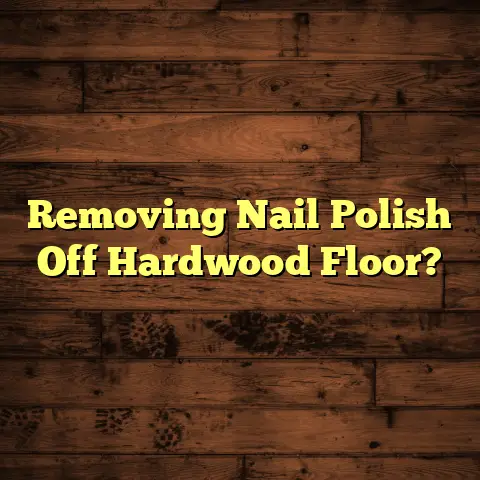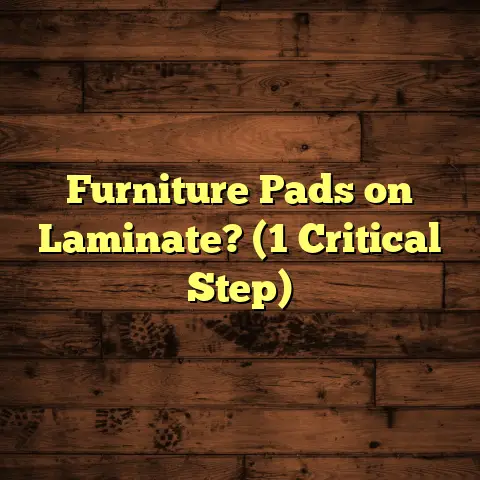How To Epoxy Garage Floor? (5 Steps To Pro Finish!)
(5 Steps To Pro Finish!)
I’m Tony, your friendly neighborhood flooring contractor.And let me tell you, in today’s world of smart homes, we’re not just talking about thermostats and light bulbs.
We’re talking about a fully integrated living experience, and that includes your garage!
Think about it: Your garage is the unsung hero of your smart home, often overlooked but crucial for storage, projects, and, of course, your vehicles.
That’s why I’m seeing more and more homeowners ditching the drab, cracked concrete and opting for a sleek, durable epoxy garage floor.
It’s not just about looks, folks. It’s about creating a functional, easy-to-maintain space that complements your smart home lifestyle.
Ready to transform your garage from a forgotten space into a showroom-worthy extension of your home?
Let’s dive into my 5-step guide to achieving a pro-finish epoxy garage floor!
Section 1: Understanding Epoxy Flooring
So, what exactly is epoxy flooring?
Simply put, it’s a thermosetting polymer coating made up of two main components: resin and a hardener.
When these two are mixed, a chemical reaction occurs, creating a rigid, plastic-like material that bonds tenaciously to the concrete surface.
Think of it like super-strong glue that hardens into a rock-solid shield.
This unique chemical composition is what gives epoxy its incredible durability and resistance to all sorts of nastiness.
The Benefits of Epoxy Garage Flooring
Why am I so passionate about epoxy garage floors?
Because the benefits are HUGE!
Here’s a quick rundown:
- Stain Resistance: Oil spills? No problem! Epoxy is virtually impervious to stains, making cleanup a breeze.
- Chemical Resistance: Battery acid, brake fluid, you name it. Epoxy can handle it without breaking a sweat.
- Impact Resistance: Dropped a wrench? No worries! Epoxy can withstand heavy impacts without cracking or chipping.
- Aesthetic Appeal: Let’s be honest, epoxy floors look fantastic! They instantly upgrade the look of your garage, creating a clean, professional, and inviting space.
- Increased Home Value: A well-done epoxy floor can increase the resale value of your home. It shows that you care about the details.
I’ve seen firsthand how an epoxy floor can transform a dreary garage into a bright, functional workspace.
It’s a game-changer!
Different Types of Epoxy Coatings
Now, not all epoxies are created equal. Here’s a quick look at the different types you’ll encounter:
| Epoxy Type | Pros that’s why I always recommend doing your research!
- 100% Solid Epoxy: This is the gold standard. It contains no solvents or water, resulting in a thick, durable coating.
- Water-Based Epoxy: Easier to apply and clean up, but less durable than 100% solids.
- Solvent-Based Epoxy: Strong and durable, but contains volatile organic compounds (VOCs) that can be harmful.
For most garage applications, I recommend a 100% solid epoxy for its superior durability and long-lasting finish.
Section 2: Preparing for the Epoxy Application
Alright, now for the nitty-gritty.
Preparation is KEY to a successful epoxy floor.
Trust me, I’ve seen too many DIY projects go south because of poor prep work.
Don’t skip this step!
Tools and Materials
Before you even think about cracking open that epoxy kit, make sure you have everything you need on hand.
Here’s my essential checklist:
- Safety Gear: Safety glasses, gloves, respirator (especially for solvent-based epoxies).
- Cleaning Supplies: Shop vac, broom, mop, degreaser (specifically designed for concrete).
- Concrete Repair: Concrete patch or filler for cracks and imperfections.
- Etching Solution: Concrete etcher or muriatic acid (follow safety precautions!).
- Epoxy Kit: Choose a high-quality kit with sufficient epoxy for your garage size.
- Mixing Tools: Mixing buckets, drill with mixing attachment.
- Application Tools: Roller frame, roller covers (epoxy-resistant), squeegee (optional).
- Spiked Shoes: For walking on the wet epoxy.
- Painter’s Tape: For masking off walls and edges.
Having everything ready beforehand will save you time and frustration.
Preparing the Garage Floor
Now for the real work. Here’s how to prep your garage floor for epoxy:
- Remove Everything: Clear out your garage completely. This includes cars, tools, storage bins, everything!
- Sweep and Vacuum: Thoroughly sweep and vacuum the entire floor to remove loose debris.
- Degrease: Use a concrete degreaser to remove any oil stains or grease spots. Follow the manufacturer’s instructions.
- Repair Cracks: Fill any cracks or imperfections with a concrete patch or filler. Let it dry completely.
- Etch the Concrete: This is crucial for proper epoxy adhesion. Use a concrete etcher or muriatic acid to create a slightly rough surface. Follow the manufacturer’s instructions carefully and wear appropriate safety gear.
- Rinse Thoroughly: After etching, rinse the floor thoroughly with water and let it dry completely.
- Test for Moisture: Tape a small piece of plastic sheeting to the floor. After 24 hours, check for condensation underneath. If there’s moisture, your floor isn’t dry enough.
I cannot stress enough how important etching is.
It’s like sanding wood before painting – it gives the epoxy something to grip onto.
Ventilation and Temperature Control
Epoxy application requires proper ventilation and temperature control.
Ideally, you want a temperature between 60-90°F (15-32°C) for optimal curing.
Open garage doors and windows to ensure good airflow.
If using a solvent-based epoxy, a respirator is a must!
Section 3: Step-by-Step Epoxy Application Process
Okay, the moment you’ve been waiting for!
Let’s get that epoxy on the floor!
Step 1: Cleaning the Garage Floor
Even after all that prep, it’s important to give the floor one last cleaning before applying the epoxy.
Sweep or vacuum the floor to remove any dust or debris that may have settled.
A tack cloth can also be helpful for picking up any remaining particles.
Step 2: Repairing Cracks and Imperfections
If you skipped this step earlier, now’s your last chance!
Use a concrete patch or filler to fill in any cracks or imperfections.
Make sure the patch is completely dry before moving on.
Step 3: Etching the Concrete Surface
Again, etching is crucial for proper adhesion.
If you haven’t already etched the floor, follow the instructions on the concrete etcher or muriatic acid carefully.
Rinse the floor thoroughly and let it dry completely.
Step 4: Mixing the Epoxy
This is where precision is key!
Carefully follow the manufacturer’s instructions for mixing the epoxy components.
Typically, you’ll need to mix the resin and hardener in a specific ratio.
Use a drill with a mixing attachment to ensure thorough mixing.
Don’t skimp on the mixing time – you want to make sure the epoxy is completely homogenous.
I’ve seen folks ruin entire batches of epoxy by not mixing properly.
Step 5: Applying the Epoxy
Now for the fun part!
- Pour: Pour the mixed epoxy onto the floor in a long, even ribbon.
- Spread: Use a roller or squeegee to spread the epoxy evenly across the floor.
- Overlap: Overlap each pass slightly to ensure complete coverage.
- Back Roll: After spreading the epoxy, back roll the entire floor with a clean roller to remove any roller marks or imperfections.
- Second Coat (Optional): For added durability, apply a second coat of epoxy after the first coat has dried completely.
Remember to wear spiked shoes if you need to walk on the wet epoxy.
Also, work in sections to ensure you have enough time to apply the epoxy before it starts to cure.
Section 4: Finishing Touches and Curing
Almost there!
Now for the finishing touches that will take your epoxy floor to the next level.
Adding Decorative Elements
Want to add some flair to your epoxy floor?
Consider adding color flakes or metallic pigments during the application process.
- Color Flakes: Sprinkle color flakes onto the wet epoxy after the first coat. Once the epoxy is dry, scrape off any loose flakes and apply a clear topcoat.
- Metallic Pigments: Mix metallic pigments into the epoxy before applying it to the floor. This will create a shimmering, metallic effect.
I personally love the look of metallic epoxy floors.
They add a touch of luxury and sophistication to any garage.
Curing Time and Conditions
Curing is the final and most crucial step in the epoxy application process.
The curing time will vary depending on the type of epoxy you use and the temperature and humidity levels.
Generally, it takes about 24-72 hours for the epoxy to fully cure.
During this time, it’s important to keep the garage door closed and avoid walking on the floor.
Also, make sure the temperature and humidity levels are within the recommended range for optimal curing.
Maintaining Your Epoxy Floor
Once your epoxy floor is cured, it’s important to maintain it properly to ensure its longevity.
Here are a few tips:
- Clean Regularly: Sweep or vacuum the floor regularly to remove dirt and debris.
- Mop as Needed: Mop the floor with a mild soap and water solution as needed.
- Avoid Harsh Chemicals: Avoid using harsh chemicals or abrasive cleaners, as they can damage the epoxy coating.
- Use Floor Mats: Place floor mats under heavy objects or in areas with high traffic to prevent scratches or damage.
With proper care and maintenance, your epoxy garage floor will last for many years to come.
Conclusion
So, there you have it!
My 5-step guide to achieving a pro-finish epoxy garage floor.
Upgrading your garage floor with epoxy is not only a practical choice but also a step toward creating a cohesive, stylish, and functional home environment.
And in today’s world of smart homes, that’s more important than ever.
So, what are you waiting for?
Transform your garage into a showroom-worthy space today!
And as always, if you have any questions or need assistance, don’t hesitate to reach out.
Happy flooring!





